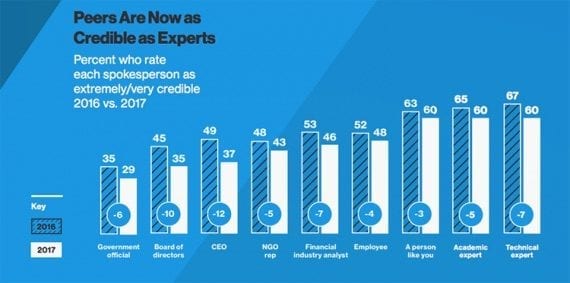Product reviews and ratings help ecommerce shoppers make important buying decisions. Small online retailers, particularly those selling unique items, should encourage reviews and listen to customer feedback.
“Consumers have long relied on advice and recommendations from others before making purchasing decisions,” wrote the Pew Research Center’s Aaron Smith and Monica Anderson in a December 2016 online shopping and ecommerce report.
“A substantial majority of the public now incorporates these customer ratings and reviews into their decision-making processes when buying something new: Fully 82 percent of U.S. adults say they at least sometimes read online customer ratings or reviews before purchasing items for the first time, including 40 percent who say they always or almost always do so.”
Product Reviews in an Era of Distrust
Interestingly, the Pew Research Center’s findings related to reviews and store ratings may be considered in the light of what public relations firm Edleman calls “an implosion of trust.”
“The 2017 Edelman Trust Barometer finds that two-thirds of the countries we survey are now “distrusters” (under 50 percent trust in the mainstream institutions of business, government, media and [non-governmental organizations] to do what is right),” wrote Edleman President and C.E.O. Richard Edleman in the opening of his company’s report.
Among its various arguments for the decline of trust, the Trust Barometer points out that, globally, survey respondents trust peers (60 percent) as much as they trust academic experts (60 percent) or technical experts (60 percent).

In the past, people tended to trust experts more than friends as sources of authoritative information, but now consumers tend to trust each other as much as anyone. Source: Edelman.
This data is in the context of how much folks trust the media (and trust for all groups declined relative to Edelman’s 2016 report). But it may also help to explain why shoppers trust reviews and ratings. Shoppers believe that peers are as trustworthy as professionals.
This is not to say that shoppers blindly accept what they read in product reviews. Pew reports that just about 51 percent of shoppers trust product reviews generally. But it does show that product reviews are important.
Regardless of the Edleman report, online shopping is on the rise. Pew’s Smith and Anderson reported that 79 percent of American shoppers have made an online purchase, including 51 percent of consumers who have made a purchase via a smartphone. By comparison, when Pew first started to survey consumers about online shopping behavior in June 2000, just 22 percent of Americans had made an online purchase.
This growth in online shopping shows that consumers do tend to trust online retailers as a group. Each particular retailer, then, is responsible to earn trust for its own business. One possible way to earn trust is to include product or even business ratings and reviews.
Encouraging Authentic Reviews and Ratings
Since shoppers tend to use online reviews and ratings to make new or important online buying decisions, if an online store can encourage authentic reviews and ratings, it can help some shoppers convert, producing more sales.
For some small or even mid-sized ecommerce businesses, getting product reviews is not easy. Simply including an online form on each product detail page is not enough.
There are, however, some things merchants can do.
Include Reviews from External Sources
If your online store sells products that are also available more generally, you can include reviews from external sources on your site’s product detail pages.
These external reviews might be a tweet, a public Facebook post, a description from Pinterest, something from Reddit, or even an unboxing video on YouTube.
Properly reference the primary source, don’t take reviews from competitors, and choose reviews that will help your customers.
Ask Customers for Reviews
The Pew Research Center report cited above found that about 10 percent of American shoppers almost always write reviews of products purchased and better than 40 percent sometimes write them.
Online stores can simply ask customers to rate or review the products from a recent order. This may be a personal note to a loyal shopper or a triggered email, programmed to go out a few days after a purchase.
Don’t Delete Negative Reviews
If your site receives a legitimate negative review, don’t delete it. A PowerReviews and Northwestern University report showed “that the occasional negative review can actually have a positive impact on your bottom line. The probability of a product being purchased peaks when its average rating is between 4.2 and 4.5 stars. After the average star rating surpasses 4.5, purchase probability declines because consumers perceive perfect ratings as too good to be true.”
What’s more, if you publicly address the negative review and solve the customer’s problem, other shoppers will know you’re willing to help.




